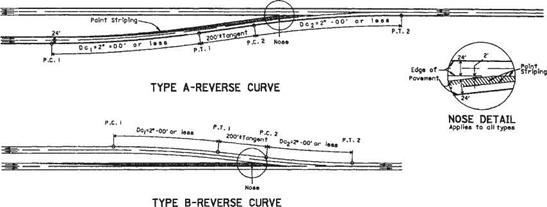SERVICE ROADS
Service roads, or frontage roads, as they are sometimes called, are used to enhance capacity on the mainline, control access, serve adjacent properties, or maintain traffic circulation. They permit development of adjacent properties while preserving the through character of the mainline roadway. Service roads may be either one-way or two-way, depending on where they are located and the purpose they are intended to serve.
Although the alignment and profile of the mainline may have an influence, service roads are generally designed to meet specific criteria based on functional classification (usually “local”), traffic volumes, terrain or locale, and design speed. Two features, however, are unique to service roads and are further discussed below. They are (1) the separation between the service road and mainline and (2) the design of the crossroad connection.
The farther the service road is located from the mainline, the less influence the two facilities will have on each other. A separation width that exceeds the clear zone measurement for each roadway is desirable. However, the separation should be at least wide enough to provide normal shoulder widths on each facility, and also to accommodate surface drainage and a suitable physical traffic barrier. Glare screen is desirable to screen headlights when the service road is two-way.
At intersections with crossroads to the mainline, the distance between the mainline and service road becomes critical. This distance should be great enough to provide adequate storage on the crossroad approach lanes to both the mainline and service road. The recommended minimum distance between the mainline and service road pavement edges is 150 ft (46 m) in urban areas and 300 ft (91 m) in rural areas. In addition, the designer should check the adequacy of stopping sight distance on the crossroad as well as intersection sight distance at the service road.
|
|

TYPE C-TAPERED

TYPE D-ON CURVE






Leave a reply